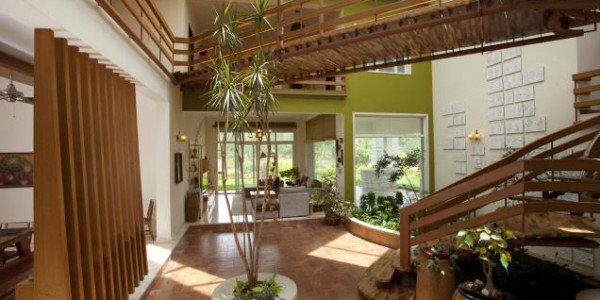Taylor Scott International News
NANDHINI SUNDAR Timber in house design. The strength of timber is dependent on its usage and seasoning. But what sets it apart from other building materials is its beauty, says Nandhini Sundar Use of wood in housing is as old as dwellings, dating back to the very first hut that was built with tree branches and leaves. While history has seen many experiments with wood, where it featured as the main structural element, weaving in intricate geometrical concepts, incorporating arches and round shapes in timber frames, currently its use is more in aesthetics than functionality. Wood features as façade, on ceilings, walls, floors, furniture, and artefacts, meeting essentially the aesthetic requirements. Interestingly, every piece of timber has a different coefficient of strength. The strength is dependent on its usage and seasoning. What sets it apart from other building materials is its beauty, warmth and value besides cutting down on carbon emissions when plantation wood is opted for. Wood, when used in the interiors as panelling, or as rafters in the ceiling, or heavily in windows, on floors, can add a warmth and old world charm to the décor depending on the manner of depiction. Furniture made of wood, even sans intricate carving, can lend a rich tone. When represented in exotic forms, it appears stately and opulent, totally transforming the décor. Given the extensive use of wood historically in structures and interiors, most of the thematic representations of décor calls for extensive use of timber. While hardwood tends to last for centuries with little maintenance when seasoned right and kept indoors, wood can also be highly manipulated. It can be bent, sanded, cut, joined, and strengthened with pins. Interestingly no two pieces of wood are alike, which adds to its versatility. Natural seasoning Says Architect Satish Naik, Satish Naik & Associates, “Seasoning of wood can be done artificially as well as naturally though natural seasoning is lengthier, requiring soaking of logs in water and later drying in sunlight. A well-seasoned wood does not warp, bend or slit.” The manner of usage also determines its strength. For instance, teak yields maximum strength when used vertically while bamboo is totally flexible, allowing any manner of use. Says Architect Dinesh Verma, ACE Group Architects, “Bamboo can be assembled faster than other types of timber and withstands better harsher weather conditions.” Teak lends itself to decoration given its natural properties while bamboo serves as an excellent support for roofs where it can serve as structural element for the entire stretch of walls as well as ceiling. Stunning dwellings can be created using only bamboo. In rural areas, entire houses are made of bamboo. Bamboo is also excellent for creating exotic varieties of furniture and artefacts. “Bamboo roots come in exquisite shapes that lend themselves to creating mindboggling varieties of art pieces and furniture,” adds Naik. Some of the early uses of timber veered around mahogany, ebony, rose, teak, camphor and walnut. These varieties were crafted to reflect superb craftsmanship. Rosewood, teak and walnut are still sparingly used though the opulent mahogany and the queen of timber, ebony, have gone completely out of circulation, with ebony now listed under the preserved category. The black-coloured ebony is also credited with healing properties, manifesting as hand railings in mansions. Interestingly, only a small portion of ebony’s trunk forms the core of the timber with the rest assuming a lighter shade. Rare Paduk Paduk is another interesting variety of timber found in the forests of Andaman and is unique as it is grown only in this region. “The rare Paduk, referred as the chameleon of timber, has an interesting characteristic of losing its colour completely when exposed to sunlight and regaining it once brought back under shade,” says Naik. Many new varieties of timber have now come to use, each with their own unique individual characteristics, notable ones being sal wood, beach wood, steam wood, American walnut, and rubber wood. Cane too has come to occupy a significant space in timber varieties. Given its lightness, cane is becoming more popular especially with exotic varieties of furniture being crafted using it. Interestingly, even discarded wooden railway sleepers form excellent material for outdoor use. Adds Verma, “These can be used as garden seating elements, to pave the pathways in the garden, even for cladding the façade to give a woody cottage look to the residence.” One of Verma’s residence projects displays such exterior cladding where the hard wooden planks have been bolted in to facilitate easy removal for maintenance. Taylor Scott International
Taylor Scott International, Taylor Scott








